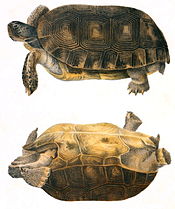- Bowsprit tortoise
-
Bowsprit Tortoise 
Scientific classification Kingdom: Animalia Phylum: Chordata Class: Sauropsida Order: Testudines Suborder: Cryptodira Superfamily: Testudinoidea Family: Testudinidae Genus: Chersina Species: C. angulata Binomial name Chersina angulata
(Schweigger, 1812)[1]The Bowsprit tortoise (Chersina angulata), also known as the Angulate tortoise or Rooipens, is a species of tortoise found in dry areas and scrub forest in South Africa. This tortoise in the only known member of the genus Chersina.
Contents
Description
A small, shy tortoise with a relatively variable shell. They can often be distinguished by their prominent "bowsprits", which are protrusions from their lower carapace under their chins. These are used by males to fight for territory or females.[2]
Natural Range
Their natural habitat is the Fynbos, Karoo and coastal scrub vegetation of the south-western part of South Africa. This natural range extends across the Cape Floristic Region, as far north as the southern part of Namibia. In addition, small colonies have been introduced by tourists to domestic gardens in Swakopmund and Walvis Bay, further north in central Namibia. There is also a colony on Dassen Island, off the South African coast. [3]
The Bowsprit Tortoise in captivity
The Bowsprit tortoise is commonly kept as a garden pet in South Africa. It is also increasingly threatened by illegal collecting for the pet trade. Outside of their natural range and climate they do not usually survive well, so when exported overseas, these pets usually die. This is partly because they are adapted to the warm, dry, Mediterranean-type climate of South Africa. They also naturally eat a wide range of indigenous South African plants and, if kept in a garden, they require a similarly wide range of plants available to feed on. They will not stay healthy if fed only on lettuce.
This tortoise, like most reptiles, also needs to be able to regulate its own temperature, by moving between sunny and shady spots. If kept as a pet, it therefore needs a large garden where it can both warm itself in natural sunlight, as well as seek shade when necessary. It needs a dry habitat, as constant moisture is particularly bad for it. If the garden is suburban then it also should be well-fenced, so that the tortoise does not wander into the nearby streets and traffic. [4]
References
- at Honoluluzoo.org
- http://books.google.com/books?id=igNPuKzHfG0C&pg=PA21&lpg=PA21&dq=gigantea+Mauritius+introduce&source=web&ots=zUh-XUdmIu&sig=54s0JAZgqiEZIV3g8MCFfEvhmWw&hl=en&sa=X&oi=book_result&resnum=1&ct=result#PPA22,M1
- Chelonia.org
Tortoise family of turtles (Testudinidae) Genus 
Aldabrachelys Astrochelys Chelonoidis Chersina Bowsprit tortoiseCylindraspis† Geochelone Gopherus Homopus Beaked cape tortoise · Berger's cape tortoise · Boulenger's cape tortoise · Karoo cape tortoise · Speckled padloper tortoiseIndotestudo Elongated tortoise · Forsten's tortoise · Travancore tortoiseKinixys Bell's hinge-back tortoise · Forest hinge-back tortoise · Home's hinge-back tortoise · Lobatse hinge-back tortoise · Natal hinge-back tortoise · Speke's hinge-back tortoiseMalacochersus Manouria Psammobates Pyxis Stigmochelys Testudo Phylogenetic arrangement of turtles based on turtles of the world 2010 update: annotated checklist of taxonomy, synonymy, distribution and conservation status. Key: †=extinct. 1=classification unclear Order Testudines (turtles) Kingdom: Animalia · Phylum: Chordata · Class: Reptilia · Subclass: Anapsida · Order: Testudines Suborder SuperfamilySubfamily
Cryptodira Caretta · Chelonia · Eretmochelys · Lepidochelys · NatatorDermochelysDermatemydidaeDermatemysStaurotypinaeBatagur · Cuora · Cyclemys · Geoclemys · Geoemyda · Hardella · Heosemys · Leucocephalon · Malayemys · Mauremys · Melanochelys · Morenia · Notochelys · Orlitia · Pangshura · Rhinoclemmys · Sacalia · Siebenrockiella · VijayachelysAldabrachelys · Astrochelys · Chelonoidis · Chersina · Cylindraspis · Geochelone · Gopherus · Homopus · Indotestudo · Kinixys · Malacochersus · Manouria · Psammobates · Pyxis · Stigmochelys · TestudoTrionychiaCarettochelyidaeCarettochelysTrionychinaePleurodira ChelidinaeChelodininaeHydromedusinaePhylogenetic arrangement based on turtles of the world 2010 update: annotated checklist. Extinct turtles not included.
See also List of Testudines families
 Portal ·
Portal ·  WikiProjectCategories:
WikiProjectCategories:- Chersina
- Reptiles of South Africa
- Monotypic reptile genera
- Animals described in 1812
Wikimedia Foundation. 2010.
